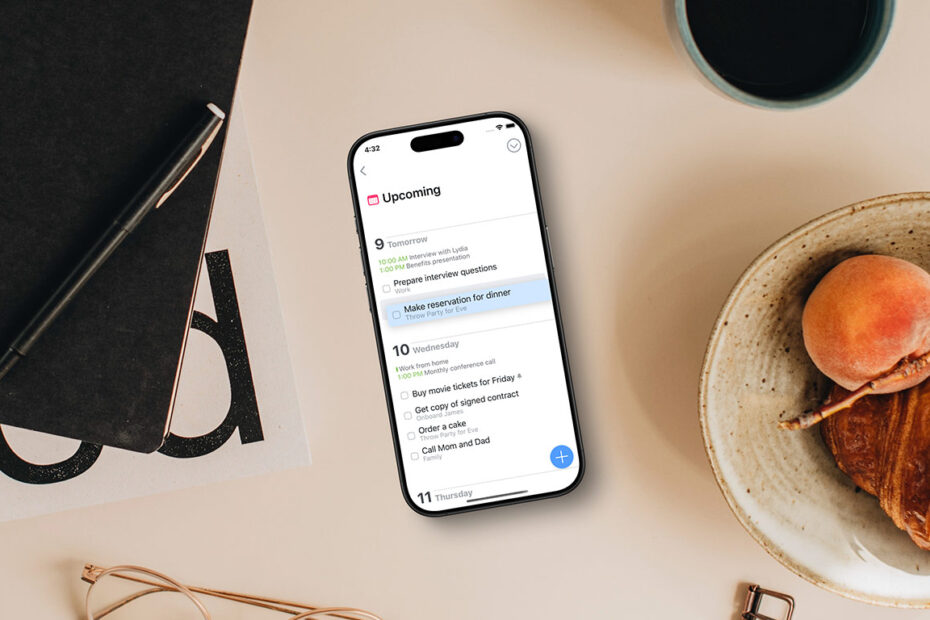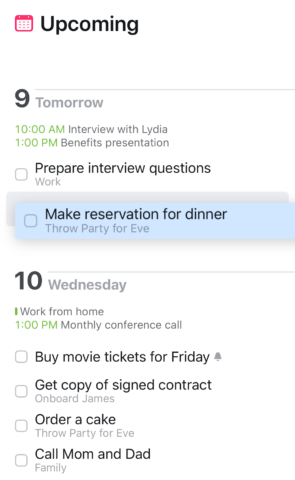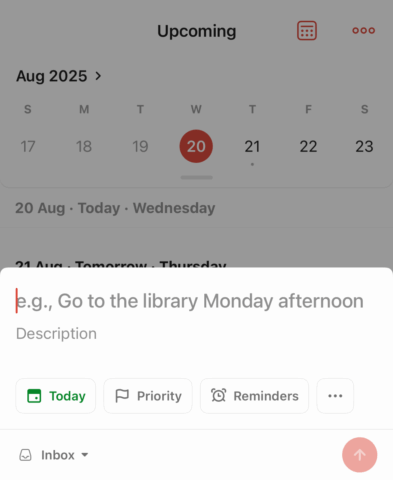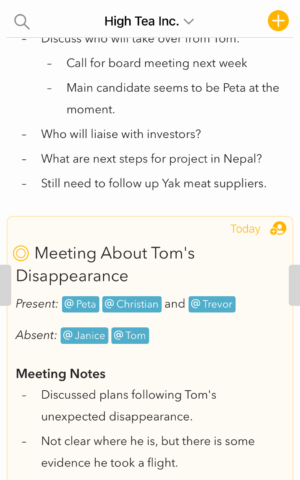Your iPhone can easily become a time waster, enticing you to fritter your life away on social networking, videos, and games. But with the right apps, your device can be a productivity powerhouse, helping you manage tasks and get things done.
This round-up is all about apps that go beyond you making the odd reminder – those to which you’d trust organizing your life. And each app brings its own individual approach to helping you get things done.
Reminders (free)
Best for Apple ecosystem integration
Reminders was once little more than a basic checklist for adding items to lists and assigning notification dates. But over the years, Apple has quietly added features that haven’t robbed its app of simplicity yet have significantly expanded the scope of what you can do with it.
Individual tasks can be made to repeat, have locations and priorities assigned, and be shared with others. Tags let you group items across multiple task lists, which can then be viewed together in a single smart list. A column (Kanban) view helps you better visualize tasks and priorities within a process. And this being an Apple product, there’s full integration with Calendar, which you can use to peruse your reminders and drag and drop them to quickly update deadlines.
There are some shortcomings. For example, as of iOS 18, there’s no way to have Reminders create a list of overdue items, without also lumping in everything that’s due today. Also, there’s no GTD-style system (today, tomorrow, later, and so on) like those found in some other task managers. But as a bundled freebie, it does most of the things that most people will need and is definitely not an app to overlook or assume won’t be enough for you.
Things ($10/£10)
Best for elegance, clarity, and focus
Things manages to simultaneously be about small details and the bigger picture. You start by stashing ideas in an inbox, and each can optionally have a hard deadline or a more abstract ‘intention’ regarding completion – be that today, tomorrow, or ‘someday’. Further organization comes from tags that link arbitrary tasks, projects that collate and structure larger goals, and ‘areas’ to separate different elements of your life.
From a visual and usability standpoint, Things is superb, with a friendly, almost playful interface. You’ll revel in the tiny pie charts in the main screen that denote how complete each project is, the integrated Quick Find feature that helps you rapidly access tasks, and how intention-based tasks roll over when incomplete – rather than the app stressing you out by adding them to an overdue list. There’s also great clarity in the app’s design, not least in the excellent Upcoming view.
There are a few drawbacks. This is solo fare – there are no collaboration features – and you cannot attach files nor location data to tasks. Custom views are limited to filter-based searches. The app isn’t cheap either: beyond the iPhone version, it costs $20/£20 on iPad and $50/£50 on Mac. That said, this is a one-time purchase, not a subscription, and the creators have to date provided years of regular updates; beyond that, the app’s elegance and efficient nature set it apart from its contemporaries.
Get Things for iPhone
Get Things for iPad
Todoist (free + IAP)
Best for working cross-platform
Todoist doesn’t muck about. Adding new tasks is swift, due to a responsive interface that enables you to quickly assign tags, priorities and deadlines, and file tasks accordingly. There’s natural language input, so you can type in the likes of “Lunch with John on Friday” or “Update weekly schedule every Monday at 10am #team” and let Todoist handle the drudge work.
For the solo user, there are additional notable features: filters you save to the main screen that adjust your view based on user-defined criteria, and a ‘karma’ system for working up a streak of getting things done. But the app really excels when you collaborate with others, adding links and attachments, making comments, and digging into a task’s history.
What you don’t get is much ‘Appleness.’ The app feels comparatively basic and doesn’t pull in Calendar data. However, it is available across a range of platforms – including the web – which is ideal for collaboration. The free tier is generous too, and may be enough for a solo user. But if you feel restricted, you can opt to pay $48/£48 per year to up active projects from five to 300, attach larger files, use more filters (150 rather than just three), and set custom task reminders.
TickTick (free + IAP)
Best for combining tasks and wellbeing
Despite sporting a moniker that suggests a bomb’s about to go off, TickTick has a lot going for it. The main view resembles a basic task manager, where you add items with due dates, tags, and priority flags, and then dump them in the inbox (to later sort) or a list. What makes TickTick interesting is its range of built-in features designed to help you focus and reduce stress.
You get Today and Inbox views, the former including a focus mode to encourage you to deal with one task at a time. Beyond typical to-do views, there’s the Eisenhower Matrix, which lets you rearrange tasks into boxes for urgent, important, both, or neither. Additional tabs include a handy events countdown, a Pomodoro timer for distraction-free work sprints, and a habit tracker – the app’s creator reasoning that habits can often be more beneficial to you than dealing with timed goals and defined projects.
Generously, much of this functionality is free. However, there is a paid tier – $35/£35 per year – that unlocks alternate calendar views, filters, and themes, along with greater capacity for lists, tasks, attachments, habits, and countdowns. Either way, TickTick is a novel take on a task manager that successfully does something a bit different.
Agenda (free + IAP)
Best for freeform tasks with context and history
All task managers afford you some flexibility, but Agenda is the most freeform around. It’s like someone expanded on the basic organization elements in Apple’s Notes.
Tasks can have any combination of text, headings, lists, tables, photos/scans, dividers, tags, and even freeform sketches. But also, two sidebars can be pulled in from the screen edges. From the right, you get a calendar and links to recently edited and related notes. From the left, you can access notes you’ve placed in the ‘On the Agenda’ overview, today’s tasks, search, and projects.
Smartly, Agenda includes sample projects, which show off how the app can be used for everything from planning to journals. Dig into them and you’ll grasp how useful context and the ability to scroll back through lists and text can be to task management. They also instantly show how Agenda is far more than a mere checklist – albeit overkill and overly complicated if your task needs are basic.
The app’s free to try, gating premium features – templates; subcategories; pinned notes and footnotes; annotations – behind a paywall. It costs $35/£35 per year or $120/£120 lifetime. But unlike many other apps, Agenda permanently unlocks premium features that were available while you subscribed. Whether you choose to splash out or not, Agenda’s worth a look for a unique, genuinely useful approach to task management.
OmniFocus 4 (from $75/£75 or free + subscription)
Best for pro-grade task management
Our final choice is a real powerhouse for anyone who takes task management seriously. OmniFocus 4’s ‘universal design’ is smart on iPhone but also ensures a familiar experience wherever you use the app, and all your projects and workflows sync between devices. You can quickly work up projects, tags, and deadlines, with expandable outlines that scale from quick lists to complex action groups, all editable on your phone.
On iPhone, there’s a need for greater immediacy than on other devices, and OmniFocus recognizes this in allowing you to quickly jump between custom views, and you can use Home Screen widgets to put your most vital tasks front and center. If you live and breathe GTD, you’ll likely relish the deep customization, rich automation, and precision on offer, notably in the Pro version.
However, all this power means there’s a steep learning curve – and a steep price tag – compared to many other task managers. This isn’t a good choice for quick to-dos – it’s a serious pro-grade app. But if your needs align and you’re happy to splash out $75/£75 for Standard, $150/£150 for Pro, or $100/£100 per year for a Pro subscription, OmniFocus 4 is a gold standard task manager.













